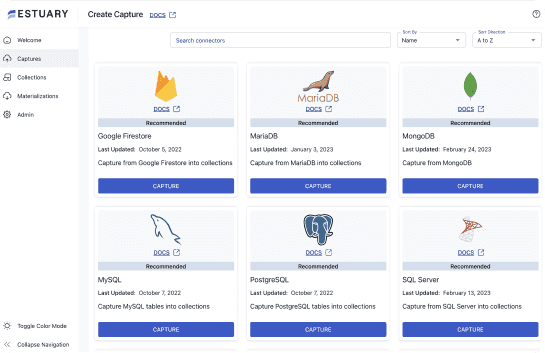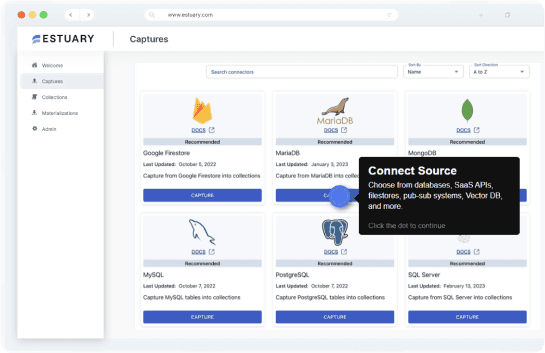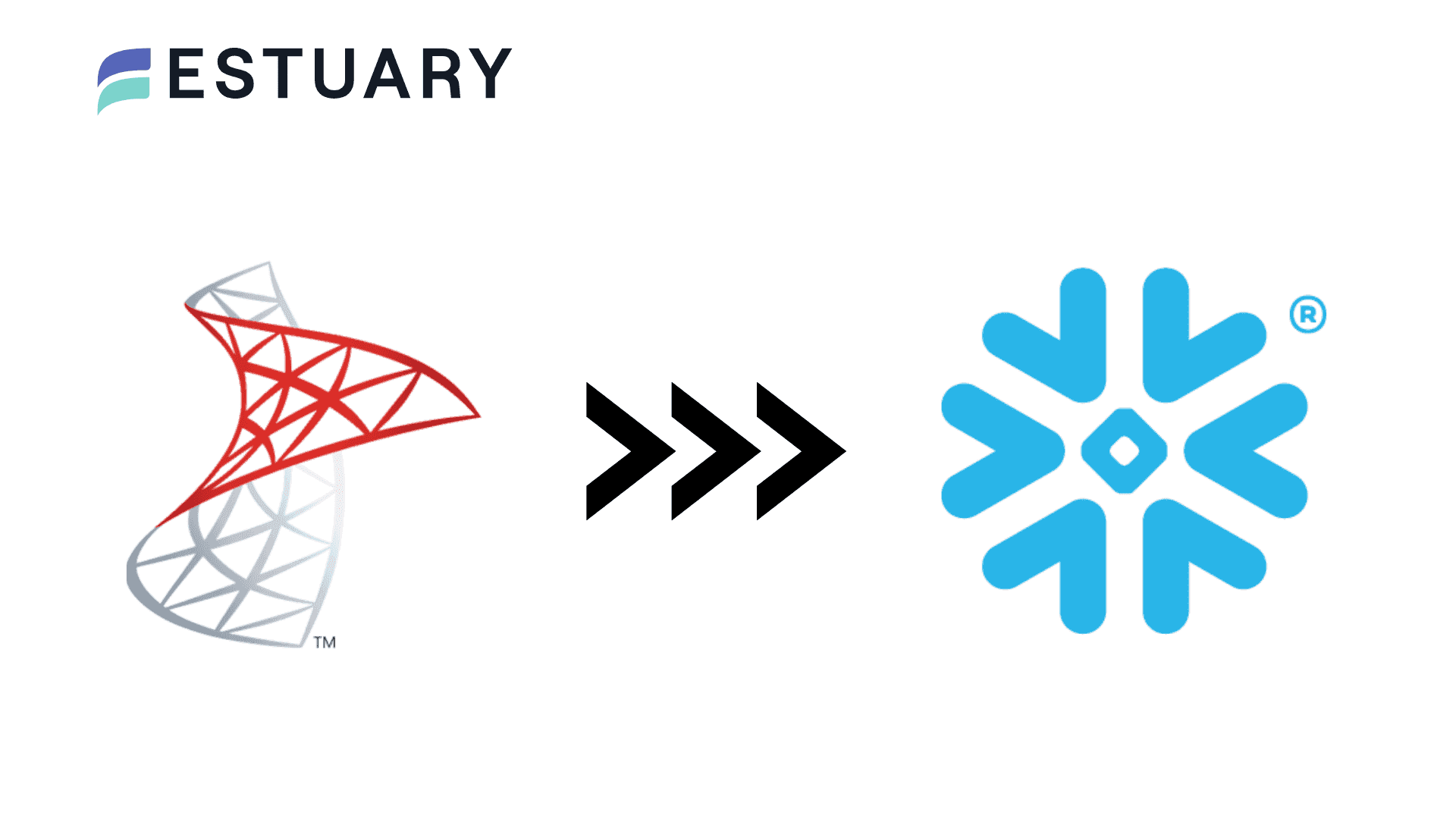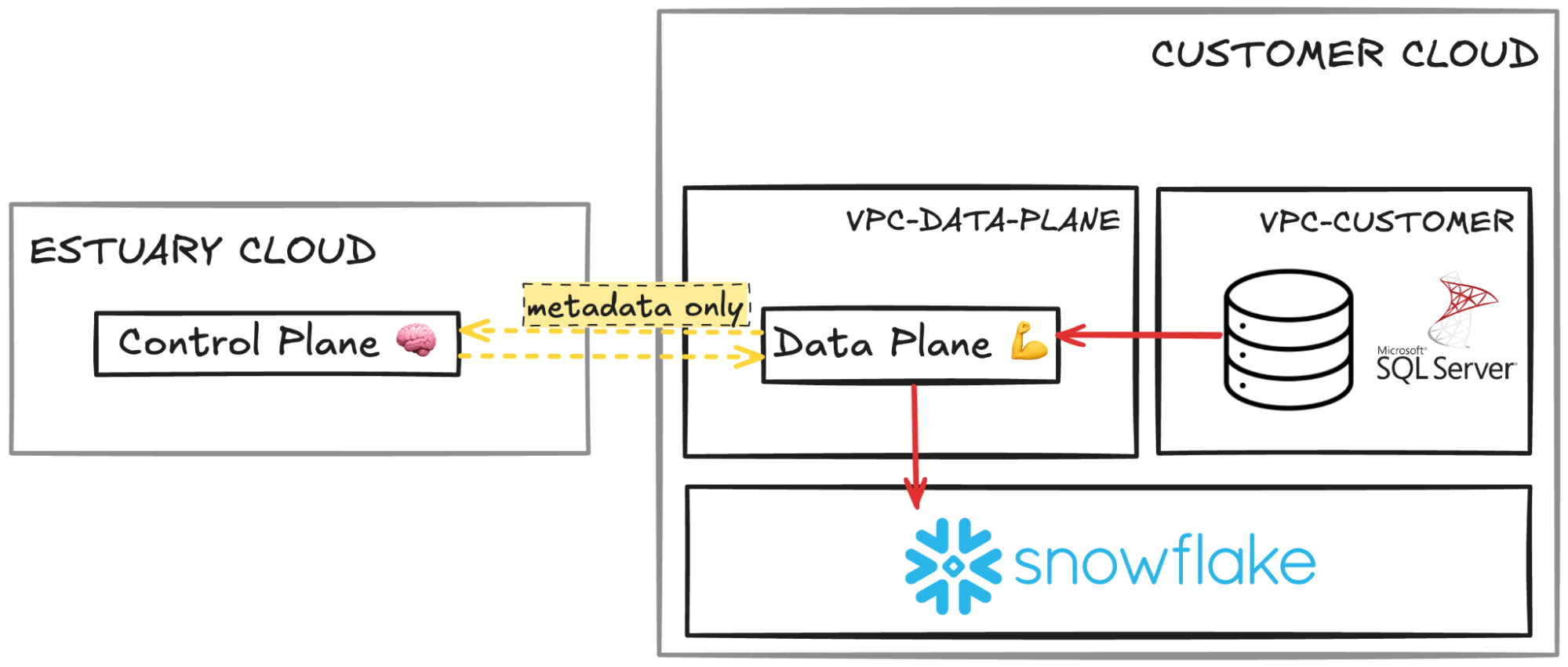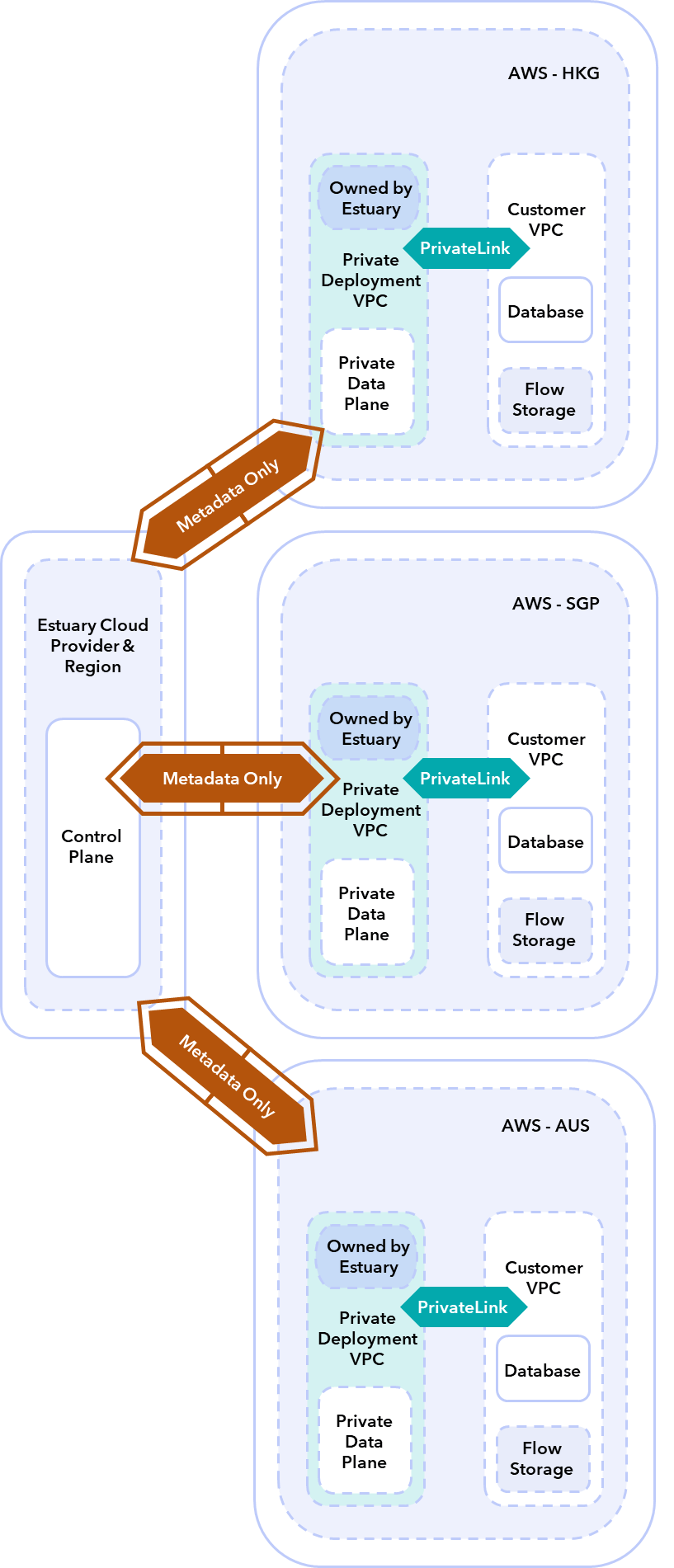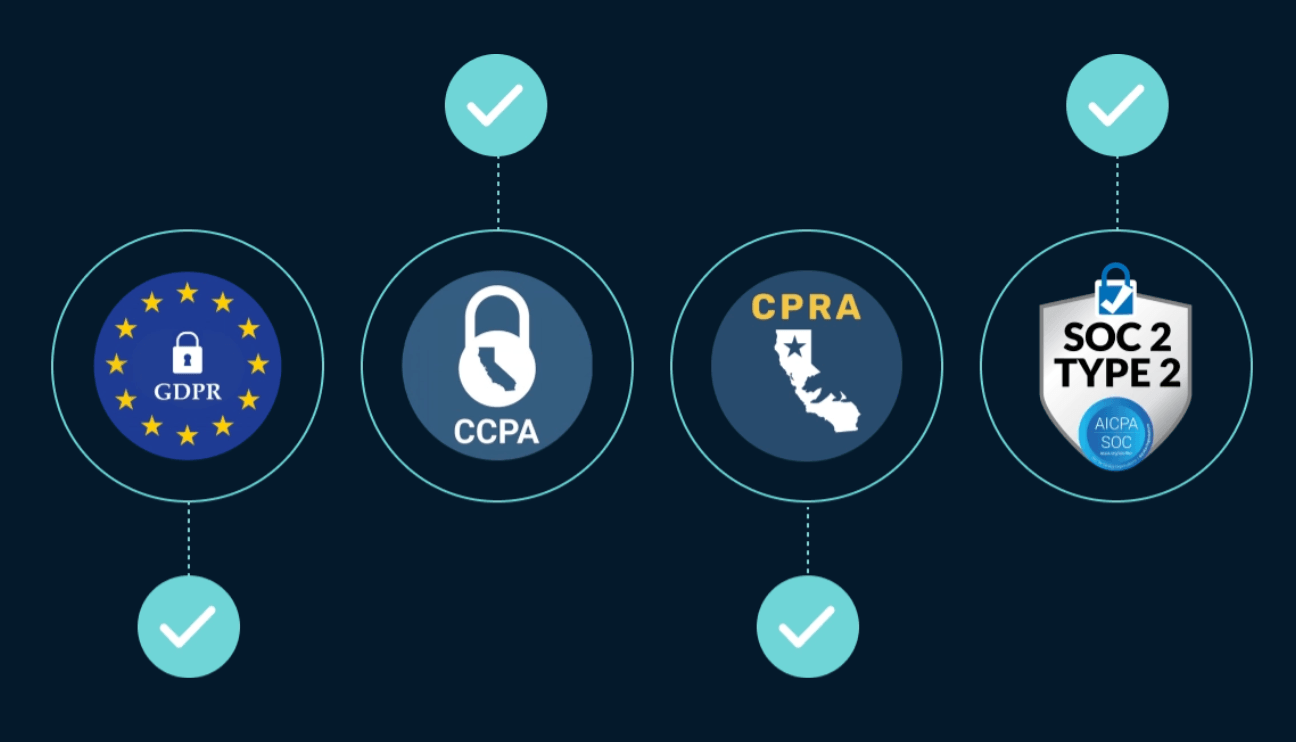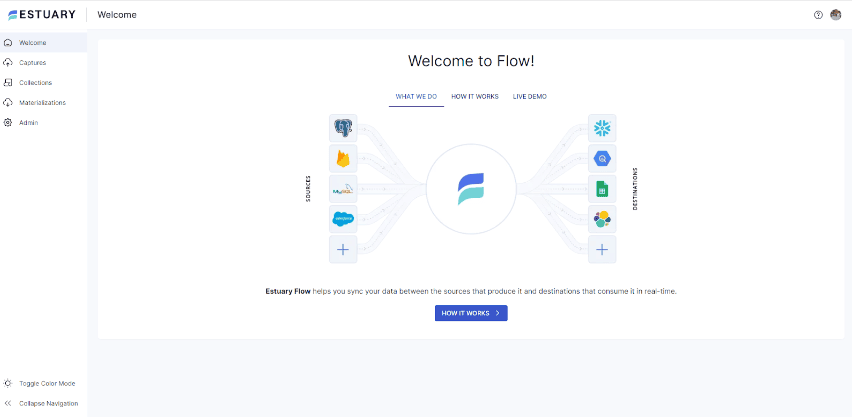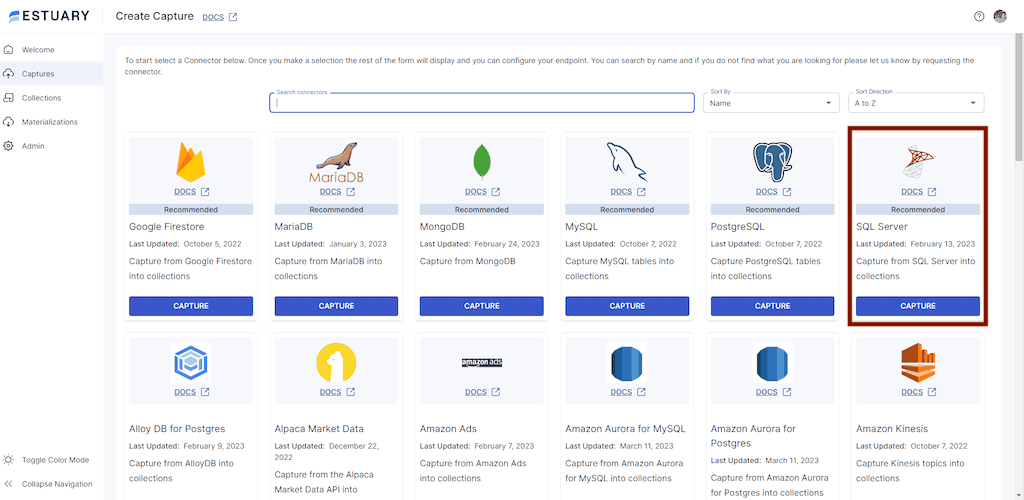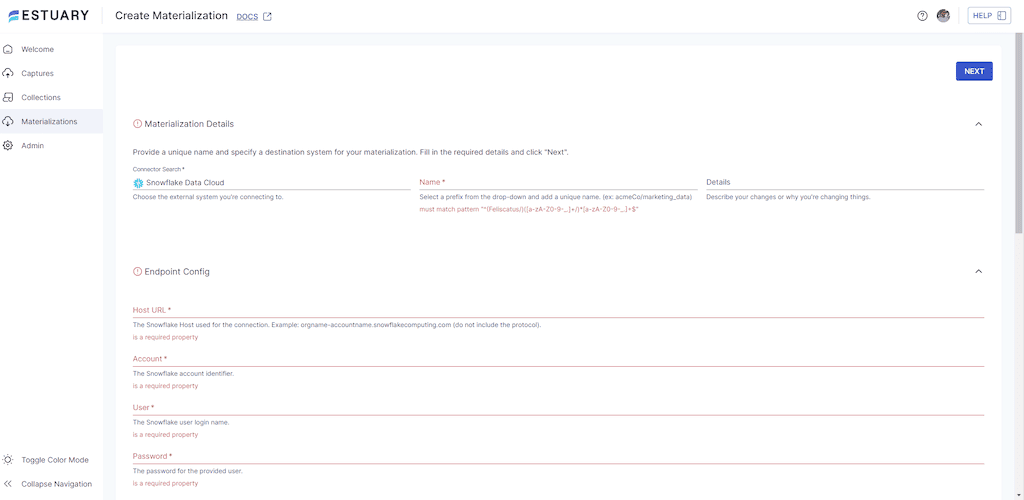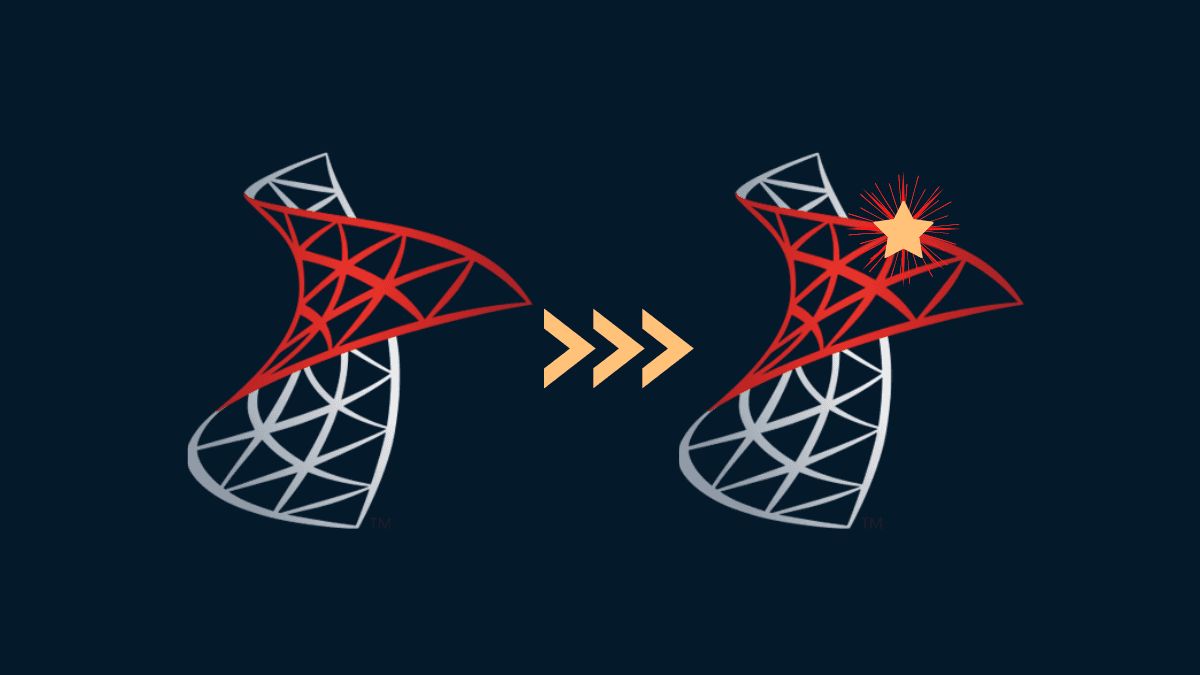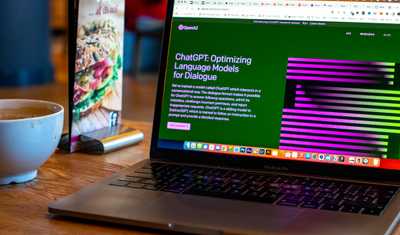
Large enterprises running Microsoft SQL Server face a common challenge: how to efficiently move data to modern cloud data warehouses like Snowflake while maintaining security, performance, and real-time accuracy. Traditional batch ETL tools struggle with the scale and complexity of enterprise SQL Server deployments, especially when dealing with:
- Private VPC-isolated databases
- On-premises SQL Server instances behind corporate firewalls
- Strict compliance requirements prevent data from leaving specific regions
- High-volume transactional systems generating millions of changes per hour
- Complex schemas with hundreds of tables and relationships
This is where Estuary Flow's Bring Your Own Cloud (BYOC) deployment model fundamentally changes the game for enterprise data integration.
Understanding BYOC: Security-First Architecture
BYOC allows enterprises to run Estuary Flow's data movement infrastructure entirely within their own cloud environment or on-premises data centers.
Here’s how BYOC helps meet enterprise-grade security and compliance requirements:
- Your data never leaves your network perimeter: The Flow runtime executes inside your VPC, connecting directly to your private SQL Server instances and writing to your Snowflake warehouse without traversing the public internet.
- You can still enjoy SaaS convenience: The Flow dashboard is available to manage all of your related resources and see statistics, metrics about your data flows.
- You maintain complete control: All compute resources, network policies, and access controls remain under your governance. Flow operates as a guest in your environment, not as an external service pulling your data.
- Compliance becomes manageable: Whether you're dealing with HIPAA, SOC 2, PCI-DSS, or internal data residency requirements, BYOC ensures your data movement adheres to your policies.
By choosing BYOC, you ensure that your SQL Server to Snowflake data pipelines remain secure, compliant, and under your complete control while still benefiting from real-time performance and modern tooling.
SQL Server Change Data Capture (CDC): The Technical Foundation
Estuary Flow leverages SQL Server's native Change Data Capture (CDC) capabilities to achieve real-time data synchronization. Here's what makes SQL Server CDC unique and powerful:
How SQL Server CDC Works
SQL Server CDC operates at the transaction log level, capturing every INSERT, UPDATE, and DELETE operation as it happens. When you enable CDC on a table:
- SQL Server creates a shadow table (called a change table) that stores all changes
- A capture job reads the transaction log and populates the change table
- The change table includes metadata like operation type, transaction time, and before/after values
Key Technical Advantages of SQL Server CDC
- Minimal performance impact: CDC reads from the transaction log asynchronously, avoiding locks on your production tables. The overhead is typically less than 5% even on high-transaction systems.
- Complete change history: Unlike trigger-based approaches, CDC captures all changes including those made by bulk operations, replication, or system processes.
- Point-in-time consistency: CDC preserves transaction boundaries, allowing you to maintain referential integrity across related tables during replication.
Enterprise CDC Considerations
For large-scale SQL Server deployments, it’s important to plan CDC configurations carefully:
- Storage planning: Change tables consume additional storage. Plan for 10-20% overhead depending on your change velocity.
- Retention management: SQL Server automatically cleans up old change data based on retention policies. Configure these carefully to balance storage costs with recovery requirements.
- Schema evolution: CDC handles schema changes gracefully, but adding or removing columns requires careful coordination with your data pipeline.
Estuary's SQL Server Connector: Enterprise-Grade CDC at Scale
The Estuary Flow SQL Server connector implements several optimizations specifically for enterprise workloads:
Intelligent Batching and Parallelization
The connector reads changes in configurable batches, processing multiple tables in parallel while respecting transaction boundaries. For a database with 100 tables:
- Initial snapshots run with configurable parallelism (typically 4-8 concurrent table reads)
- CDC streaming automatically batches changes every few seconds
- Large transactions are chunked to prevent memory pressure
This ensures low-latency ingestion without overloading your SQL Server or Snowflake environments.
Automatic Schema Detection and Evolution
Estuary Flow automatically discovers your SQL Server schema, including:
- Primary keys and unique constraints for deduplication
- Data types with automatic mapping to Snowflake equivalents
- Column additions and deletions without pipeline disruption
- Index metadata for optimization hints
Advanced Data Type Handling
SQL Server's rich type system maps cleanly to Snowflake through Flow:
- Temporal types: datetime2, datetimeoffset preserve microsecond precision
- Spatial data: geometry and geography types convert to WKT strings
- Large objects: varchar(max), varbinary(max) stream efficiently
- Computed columns: Captured if deterministic and persisted
Want more technical details? Check out the official documentation for schema mappings and connector setup.
Snowflake Destination: Optimized for Analytics
Estuary Flow's Snowflake connector leverages several platform-specific features for optimal performance:
Micro-Batch Loading With Snowflake COPY
Instead of row-by-row inserts, Flow stages data in Snowflake's internal storage and uses COPY commands:
- Changes accumulate in memory for a configurable duration (typically 5-30 seconds)
- Data compresses using Snowflake's native formats
- COPY commands load data with minimal compute credits
- Automatic retry handles transient failures
Merge Optimization for CDC Updates
For CDC updates, Flow generates efficient MERGE statements that:
- Deduplicate changes within each batch
- Apply updates idempotently (safe to retry)
- Maintain SCD Type 1 semantics by default
- Support custom merge logic for complex scenarios
Snowflake Resource Management
Flow automatically manages Snowflake resources:
- Configurable warehouse sizing based on data volume
- Automatic warehouse suspension during idle periods
- Query tagging for cost attribution
- Concurrent table loading within warehouse limits
Together, these features ensure your SQL Server to Snowflake pipelines are not just real-time, but cost-efficient and production-grade.
Real-World Enterprise Scenarios: Solving SQL Server to Snowflake Challenges with BYOC
From financial services to healthcare and retail, Estuary Flow’s BYOC deployment model enables secure, real-time SQL Server to Snowflake data pipelines tailored to complex enterprise needs.
Scenario 1: On-Premises SQL Server Behind Corporate Firewall
A financial services company runs SQL Server 2019 on-premises with no direct internet access. Their challenge: sync customer transaction data to Snowflake for analytics.
Solution with BYOC:
- Deploy Flow runtime with access to both SQL Server and the internet (via proxy)
- Configure SQL Server CDC on transaction tables
- Flow connects over private network
- Data flows through corporate proxy to Snowflake
- No data ever touches Estuary's infrastructure
Scenario 2: Multi-Region SQL Server in Private AWS VPCs
A healthcare company operates SQL Server RDS instances across three AWS regions, all in private subnets. They need consolidated reporting in Snowflake.
Solution with BYOC:
- Deploy Flow data plane within each region's VPC
- Use VPC peering or Transit Gateway for cross-region connectivity
- Each Flow instance captures regional data
- Snowflake receives merged streams with region tags
- Data never leaves AWS backbone
For more alternatives for similar deployment patterns, check out this article.
Scenario 3: High-Volume E-commerce Platform
An e-commerce platform processes 50,000 orders per minute during peak hours. Their SQL Server struggles with analytical queries competing with transactional workload.
Solution with BYOC:
- Enable CDC with optimized retention (2 hours)
- Flow captures changes with sub-second latency
- Automatic backpressure prevents overwhelming source
- Snowflake receives near real-time data for analytics
- Production SQL Server freed from analytical queries
SQL Server and Snowflake: Performance Optimization Guide
To ensure your real-time SQL Server to Snowflake pipeline performs at scale, Estuary Flow provides multiple tuning levers across source, destination, and network layers.
Source Database Optimization (SQL Server)
CDC Configuration:
plaintext-- Enable CDC with optimal settings
EXEC sys.sp_cdc_enable_table
@source_schema = N'dbo',
@source_name = N'Orders',
@capture_instance = N'dbo_Orders_v2',
@supports_net_changes = 1,
@index_name = N'PK_Orders',
@filegroup_name = N'CDC_DATA' -- Separate filegroup for performanceIndex Strategy:
- Ensure primary keys exist on all replicated tables
- Add covering indexes for initial snapshot queries
- Monitor CDC job performance via sys.dm_cdc_log_scan_sessions
Network Optimization for Data Ingestion
- Compression: Enable compression for SQL Server connections to reduce bandwidth by 60-80%
- Connection Pooling: Configure appropriate connection limits to balance parallelism with database resources
- Bandwidth Management: Use Flow's rate limiting to prevent network saturation during initial snapshots
Snowflake Optimization
- Warehouse Sizing: Start with MEDIUM warehouses and scale based on monitoring
- Clustering Keys: Define clustering keys matching your query patterns
- Staging Configuration: Use dedicated staging schemas to separate raw CDC data from transformed views
Want more insights? Learn how Estuary loads data into Snowflake with and without Snowpipe
Monitoring and Operations
Flow provides comprehensive observability for enterprise deployments:
Real-time Metrics
- End-to-end latency (typically <1 minute)
- Throughput by table (rows/second)
- Error rates and retry attempts
- Resource utilization (CPU, memory, network)
Data Quality Checks
- Row count validation between source and destination
- Schema drift detection
- Data type conversion warnings
- Constraint violation tracking
Operational Automation
- Automatic recovery from transient failures
- Self-healing for network interruptions
- Adaptive rate limiting based on source load
- Intelligent backfill for gap detection
If you’re interested in using the OpenMetrics API for observability, take a look at this article for more details.
Security & Compliance for SQL Server to Snowflake Pipelines
BYOC deployment ensures enterprise-grade security:
Encryption
- TLS 1.2+ for all network connections
- At-rest encryption using your KMS keys
- Column-level encryption support for sensitive data
Access Control
- SQL Server authentication via AD/Kerberos
- Snowflake authentication via OAuth/SAML
- Granular access control for Flow operations
- Audit logging for all configuration changes
Compliance Features
- Data masking during replication
- PII detection and handling
- Configurable data retention policies
- Integration with enterprise SIEM systems
Getting Started: Architecture Planning for SQL Server to Snowflake Integration
Before implementing your SQL Server to Snowflake pipeline, consider these architectural decisions:
- Deployment Model: Choose between BYOC or private deployment based on your infrastructure standards
- Network Topology: Map out network paths between SQL Server, Flow runtime, and Snowflake, including firewall rules and proxy configurations
- Resource Sizing: Estimate compute and storage requirements based on:
- Number of tables and total data volume
- Daily change rate (typically 1-10% for transactional systems)
- Latency requirements (real-time vs. near real-time)
- High Availability: Plan for redundancy with active-passive or active-active configurations
Cost Optimization Strategies
Running Flow in BYOC mode offers several cost advantages:
Compute Efficiency
- Right-size Flow runtime based on actual workload
- Use spot/preemptible instances for non-critical environments
- Implement auto-scaling for variable workloads
Network Costs
- Minimize cross-region data transfer
- Use private connectivity (AWS PrivateLink, Azure Private Endpoints)
- Compress data before transmission
Snowflake Credits
- Optimize warehouse sizing and auto-suspend settings
- Use resource monitors to prevent runaway costs
- Implement data lifecycle policies for historical data
Step-by-Step: Build Your SQL Server to Snowflake Pipeline with Estuary Flow
Setting up a real-time SQL Server to Snowflake integration is simple with Estuary Flow’s no-code platform. In just a few clicks, you can capture change data from SQL Server and stream it directly into Snowflake using Snowpipe Streaming.
Here’s how to get started:
Step 1. Create an Estuary Flow Account
- Start by signing up for a free Estuary Flow account. You can register using Google or GitHub credentials. Once inside, you’ll be greeted by a dashboard with options to capture data and materialize it to your desired destination.
Step 2. Set Up Your SQL Server to Snowflake Environments
Before building the pipeline, make sure:
- SQL Server is network-accessible and allows CDC on the tables you want to sync
- You have login credentials with REPLICATION or equivalent privileges
- Your Snowflake account is ready to receive data (you’ll need host, username, and password/API key)
[See full prerequisites for SQL Server and Snowflake]
Step 3. Capture Data from SQL Server
- Click Captures and select New capture. Navigate to and select SQL Server as your data source connector.
- Fill in the capture details with your SQL server address, database username, and password. Click Next.
- Flow will connect to your database and auto-detect all tables that support CDC
- Choose which tables you want to capture (all are selected by default)
- Click Save and Publish
Estuary will backfill historical rows and listen for real-time changes via SQL Server CDC. Each selected table becomes a versioned collection within Flow.
Step 4: Materialize Data to Snowflake with Snowpipe Streaming
- Click the Materialize collections button to transfer your captured data.
- From the connector tile, select Snowflake Data Cloud as your destination.
- Fill out the required properties in the Endpoint Configuration by choosing a unique name for your materialization. Then provide the Host URL, Account identifier, Username, and Password. Then click Next.
Flow maps each collection (from SQL Server) to a new or existing table in Snowflake. You can optionally:
- Rename the target tables
- Filter fields
- Apply in-flight transformations
No need to configure external stages like S3 or GCS. Estuary Flow uses Snowpipe Streaming under the hood to write data directly into Snowflake with sub-second latency.
- Click Save and Publish to go live.
Final Result
- Historical rows from SQL Server are fully loaded into Snowflake
- New inserts, updates, and deletes are captured in real time via CDC
- Snowpipe Streaming delivers ultra-low latency ingestion — no staging or batching
All done in a few clicks, with a no-code, production-grade pipeline
Conclusion
Migrating from SQL Server to Snowflake in enterprise environments requires more than just moving data: it demands a solution that respects security boundaries, handles scale, and maintains data integrity. Estuary Flow's BYOC deployment model, combined with native SQL Server CDC and optimized Snowflake loading, provides a production-ready answer to these challenges.
By running entirely within your infrastructure, Flow eliminates the traditional trade-offs between convenience and control. You get real-time data integration with enterprise-grade security, all while maintaining complete ownership of your data pipeline.
Ready to modernize your SQL Server to Snowflake integration? Contact our enterprise team to discuss your specific requirements and see Flow in action within your environment.
FAQs
What makes BYOC deployment secure for enterprise SQL Server to Snowflake pipelines?
Can Estuary Flow handle high-volume SQL Server workloads and schema changes?

About the author
Dani is a data professional with a rich background in data engineering and real-time data platforms. At Estuary, Daniel focuses on promoting cutting-edge streaming solutions, helping to bridge the gap between technical innovation and developer adoption. With deep expertise in cloud-native and streaming technologies, Dani has successfully supported startups and enterprises in building robust data solutions.

